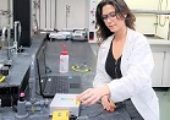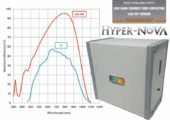Dean M. DeLongchamp and Paula T. Hammond- Department of Chemical Engineering, Massachusetts Institute of Technology
The creation of new materials systems for lightweight and flexible displays is an extremely active research field. Electrochromic displays possess a keen advantage over other technologies because it is possible for a single electrochromic pixel to produce multiple colors in addition to white, depending on applied potential. This possibility has proven quite challenging to achieve in practice. Here we present the successful fabrication of a multiply colored electrochromic electrode using layer-by-layer (LBL) assembly. The electrode films are created by exploiting intrinsic electrostatic attraction between the polycation poly(aniline) (PANI) and a negatively ionized Prussian Blue (PB) nanoparticle dispersion. The resultant organic/inorganic nanocomposites exhibit excellent smoothness and a classical linear increase in film thickness with assembly exposure steps. Electrochemical and spectrophotometric characterization confirms the distinct and noninteracting contributions from PANI and PB and reveals that both are fully electrochemically accessible even in thick, high contrast films. Switching speed is accelerated due to the incorporation of electronically conducting PANI. The PANI/PB nanocomposite undergoes an uncolored to green to blue transition over the potential range from −0.2 to 0.6 V vs K-SCE. These results validate an LBL-assembly-based intermixing strategy for the design of multiple-hue electrochromic electrode films. Future horizons include extension to other materials, with the eventual goal of creating a single electrode film or electrochemical cell capable of displaying any visible color on demand
(813) 855-8687
ContactUs@StellarNet.us






